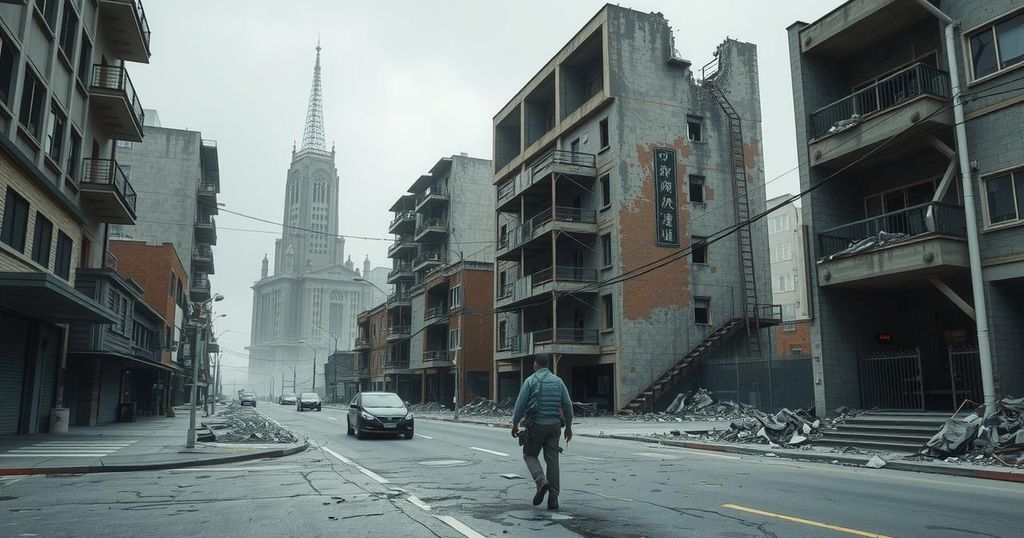Goma, DRC: Scars of War Remain Raw After M23 Takeover
Goma, DRC remains haunted by the fallout from the March 23 Movement’s takeover, which occurred more than three months ago. Heavy fighting has caused thousands of casualties and extensive displacement, leaving a humanitarian disaster in its wake. As crime rises and government structures collapse, the M23 imposes its control, making daily life fraught with peril for residents.
GOMA, DR Congo — The scars of war remain painfully evident in Goma, a city that once thrived as a border hub beneath the shadow of the imposing Mount Nyiragongo. Following the seizure of control by the March 23 Movement (M23) rebel group just over three months ago, the atmosphere in Goma has turned tense, as peace continues to be elusive for its citizens.
In late January, M23 fighters overtook Goma, a move that many residents remember all too well from 2012, when similar events unfolded. This time, the takeover has transformed the city into a battleground, with intense fighting disrupting daily life. The government reports that over 8,500 individuals have died due to the violence, and nearly 5,600 have been injured. Tragically, even those in displacement camps were targeted, with eyewitness accounts noting deaths among vulnerable groups, including pregnant women and infants.
Despite M23’s declaration of a “humanitarian ceasefire” on February 4, violence persists across North and South Kivu provinces. The rebels have continued their momentum by capturing Bukavu, the capital of South Kivu, consolidating their grip on the region. Experts believe that the current conflict may be more entrenched than prior phases, causing serious concerns for stability in the future. Underlining this aggressive ambition, Corneille Nangaa, former electoral chief and now head of M23’s political wing, has made intentions clear by pledging to “liberate the entire country,” even eyeing the capital, Kinshasa.
The city of Goma, in the aftermath of the takeover, has succumbed to a ghostly silence, punctuated not by gunfire but by a sense of chaos and oppression. Areas once filled with bustling commerce appear deserted, and the banking system has nearly collapsed, leading to crippling cash shortages. Crime has risen sharply, particularly after dark, as government functions have been rendered nearly non-existent. The M23 has stepped in to fill the void, setting up checkpoints and imposing taxes, further complicating civilian life.
With the humanitarian crisis deepening, the International Organization for Migration reports that approximately 1.2 million individuals have been newly displaced in Kivu since January. Many of those who sought refuge in Goma found themselves forced to flee yet again, leaving behind the little they had in search of safety. Families faced an abrupt evacuation ultimatum from M23 in early February, leaving camps like Bulengo and Lushagala in a rush, carrying whatever possessions they could manage. Yet, upon returning home, they often encountered devastation: burned villages, impassable roads, and their former lives reduced to dust.
The town of Sake, situated about 27 kilometers west of Goma, has experienced fierce combat. Local defense forces, supported by Congolese troops, have tried to push back against the M23 rebels with little success, resulting in considerable ruin. Danger still lingers, with unexploded ordnance scattered around fields and neighborhoods. Local resident Christian Kabuya remarked, “We have found live shells in over ten locations,” highlighting the fatalities among community members, especially children, from unexploded devices.
The ongoing conflict in Goma and the eastern DRC underscores a profound and persistent humanitarian crisis exacerbated by the M23’s resurgence. With devastating casualties and widespread displacement, the once-bustling city grapples with lawlessness and a humanitarian disaster that seems far from resolution. While international organizations strive to provide aid under challenging conditions, the future remains uncertain as the echoes of war linger starkly across the region.
Original Source: english.news.cn




Post Comment